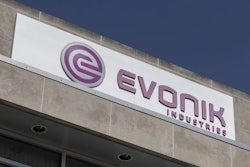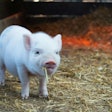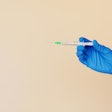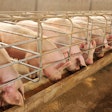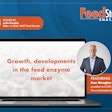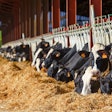
Adriano Marcon, president of Cargill Animal Nutrition, talks about nutritional tools and digital solutions that can improve efficiency in animal production.
Innovation, technology to improve on-farm efficiency (14:59)
Ann Reus: Hello and welcome to the Feed Strategy podcast. I’m your host, Feed Strategy senior reporter Ann Reus.
Innovation and technology are keys to successful animal production. What are some tools animal producers can use to improve their operations and how do they implement them? Today, I’m speaking with Adriano Marcon, president of Cargill Animal Nutrition, about nutritional tools and digital solutions that can improve efficiency in animal production.
Hello, Adriano. Thanks for being on the podcast.
Adriano Marcon: Thanks for having me, Ann.
Reus: Proper animal nutrition can address challenges faced by livestock producers. What role does animal nutrition play in improving animal health and welfare, and the sustainability of production?
Marcon: It’s an essential role. We don’t have healthy animals if you don’t have well-nourished animals. So, good animal health really starts with good nutrition. So animal nutrition is fundamental for that. We’re very focused in animal nutrition today in gut health. In the past, I think we would see that focusing on animal health, animal science, people focused on animal nutrition today, the disciplines overlap. And that’s basically one of the reasons we call our company Animal Nutrition and Health – we basically put the animal health capabilities and the animal nutrition capabilities under the same roof. So when we develop solutions that nourish animals better, we also think about gut health, we also think about enabling the host to fight diseases and to fight viruses or bacteria. So it’s really, we think about this really in an integrated fashion. So essential role of animal nutrition to ensure animal health.
Reus: What role do feed additives play in enhancing diets and how do they benefit producers?
Marcon: Well, feed additives are very important technologies. They are targeted technologies, they do different jobs in in the animal nutrition and animal health space. So, for example, mycotoxin binders help animals to deal with the natural toxins that come from feed ingredients. And if you have those toxins in the animal, they will compromise the immune status of the animal, so binders fight that. As we think about the focus on sustainability today, in Cargill Animal Nutrition, we really think about achieving zero nutrient waste. The animal is not able to digest and to absorb a lot of nutrients and still feed them. The more we help the animal to use those nutrients, the less nutrients is going to be wasted in the environment. So that’s how we improve feed conversion. When we improve feed conversion, we need less grains to feed the livestock in the world, that means we’re going to need less land, to cultivate to feed these animals. And enzymes, particularly here, do a critical job of ensuring that animals utilize as much as they can of the nutrients they are fed. So that’s another role of additives. In terms of animal health, the area we’re focusing the most now is really enabling the host, enabling the animal to fight disease and to achieve a higher immune status. And so things like prebiotics, probiotics, postbiotics, they work in a complementary fashion to help the animal to do that.
Reus: And what are some nutritional tools that can reduce antibiotic use on-farm?
Marcon: It varies a lot. So, for example, we have what we call our Cargill Nutrition System, where we have a deep, deep understanding of the nutrients that are present in the ingredients that we feed to animals. We run more than 2 million assays of ingredients every year to understand better nutrients. And as we advance our knowledge in nutrients, we understand better the dynamic of these nutrients in the animals. So, for example, fermented protein, we want to reduce that because that alters that microflora in a bad way for animals. So we use fermented protein as one of the nutrients we formulate diets. So, we can start from understanding nutrients all the way to understanding now the microflora, so in that area of understanding microflora we’re also, in Cargill Animal Nutrition, extremely busy in developing the tools that map and, frankly, profile the DNA microflora of poultry, for example, in our solution named Galleon. So what we do is we assay the excreta of poultry and we are able then to tell what’s the DNA profile of that microflora, then we can compare that DNA profile, the microflora, with a healthy profile, or with a less healthy profile, and that information allows our nutritionists and our animal science professionals on the ground to make very accurate recommendations around changing a diet, changing an ingredient in a diet, recommending a prebiotic, recommending a probiotic. So we are also developing these tools to allow our technical professionals to make more educated recommendations for customers.
Reus: You mentioned microflora. How important is better understanding of the microbiome to improving animal health?
Marcon: Well, that’s fundamental, right? I mean, a balanced and healthy microbiome enables a healthy animal and an animal that is able to absorb and to utilize more nutrients. So it’s fundamental for, for animal health, and there’s animal health challenges everyday around the world. I think my opinion is it’s the biggest short-term threat to the livestock industry in the world. I mean, see what happened in African swine fever in China, in Europe. What happened with avian influenza around the world. What happened with PEDv (porcine epidemic diarrhea virus), the virus disease in swine that hit the U.S. a few years ago. We can only have strong animals to fight these diseases and to finish their cycle in an efficient way. So, when we understand the microflora, we can alter, we can contribute to a healthy microflora that allows animals to deal with these diseases and to use nutrients in a very effective way.
Reus: How can new technologies and digital solutions improve efficiency in animal production?
Marcon: I think it’s going to be they will allow livestock producers really to leapfrog to deal with these situations in a way that wasn’t possible before. Like I said, when we profile the DNA of the microflora, we compare them to a healthy profile of bacteria that’s in the in the gut of poultry. And then we understand what causes those deviations and we can influence back those deviations into a healthier profile. These are tools that are enabled by the deep knowledge of microbiology or molecular biology, but these are tools that are only viable if you use artificial intelligence to interpret the patterns, the good patterns, the bad patterns and, through artificial intelligence, you make predictions around what you do in the diet, which probiotic you use, which prebiotic you use and you make predictions around what’s going to happen now with the microflora. In life science, we don’t talk about accuracy, but we are moving towards much more educated decisions, when you use very high-end microbiology tools, like Galleon, coupled with the data science that comes from artificial intelligence. So that’s going to be the world of industrial livestock production in the future. It’s going to be much more tech enabled, tech driven. Decisions are going to be much more accurate, because we’re going to have much better tools to understand the impact of the decisions we make.
Reus: And what is the next step for producers who want to make their production more digital and higher tech, and maybe use some of that artificial intelligence that you mentioned?
Marcon: I think that’s a very, very important question because we see the livestock world moving towards digitalization. So I think it depends on where you are on the journey, Ann. So, for example, I think most of the people, they are already using a farm management software in the swine world or in the poultry world. I mean, you can’t manage operations without a solid farm management software. Now, if you evolve this software, you’re going to plug in sensors. For example, we have this swine farm management software solution, what they do is, in addition to manage the farm and the transactions in the farm, they have internet of things-connected sensors, for example, there’s a sensor in the water, if the water is too cold, then they know that the pigs aren’t going to drink. If they don’t drink, they don’t eat. So if the water is too cold, that sensor is going to send a signal to the software to the smartphone of the person that’s managing the farm, say, hey, water is too cold, you got to do something about it, right.
So now you evolve from farm management software to more for more targeted applications. So for example, we are partnering with a new company to put cameras on the ceiling of poultry barns, those cameras are reading the live weight in real time. For us as nutritionists, what we want is to understand the growth curve of those animals and compare, if the growth curve of those animals is compatible to the nutrition we designed for that. And oftentimes it isn’t, and when it isn’t, so we can say OK, all right, there’s a deviation on day 21. Then we’re going to send a technician say, OK, there’s something going on with this flock. It’s either nutrition or it’s environment, or it might be a disease. So from farm management software to real-time growth monitoring, it’s a nice evolution. We are increasingly designing our own ecosystem of digital livestock farming solutions to help our customers to navigate this journey.
Another way to see digital applications, very high-end digital applications in the livestock world is real-time formulation. So up until now, what we have is, if you if you want precision nutrition, and you have a feed plant, you want to segregate the different batches off your macro ingredients. So few plants were designed to have many silos. So we have different batches of soybean meal, for example, this is a 46% protein soybean meal, this is a 47, this is a 48. So different silos, different profiles, we can, we can recommend the precise formulation, different silos. But that requires a lot of silos, that requires a nutritionist to change formula many times a week. Sometimes you don’t have the nutritionist at the plant available to make those changes, so what we have today is real-time formulation, we have a solution where we have sensors in the line of the feed plant that is transporting corn and soybean meal. So this sensor is picking up deviations of half a percentage point in protein or fats, for example, in the case of corn, and if the deviation goes past half a percentage point, these sensors, they’re going to send a signal to the feed plant and then we’re going to trigger an auto-reformulation process, so that we can formulate batch by batch. That is the ultimate in precision nutrition. Customers are saving money because they are extracting every single nutrient they can measure in the feed formulation. But it would say even most importantly, the nutrition design is going to be the nutrition delivered to the animal. So you are going to reduce variability in your flock.
So I started from basic applications from farm management software, all the way to precision nutrition. And there’s a lot of options along the way, but I mean, the bottom line, and this is what I really want our audience to know is that digital is going to be an integral part of livestock production going forward, it’s going to allow customers to produce livestock, animal protein more efficiently, and especially more sustainable.
Reus: Great, thank you so much for your insights.
Marcon: No, thank you, Ann. Thanks for having us.
Reus: And thanks to the audience for joining us. If you enjoy the Feed Strategy podcast, you can subscribe wherever you get your podcasts. I’m Ann Reus for Feed Strategy.



